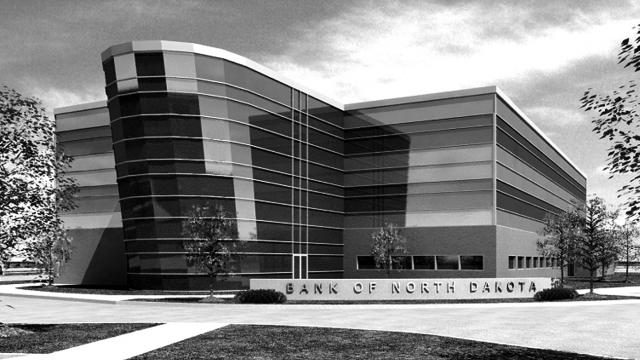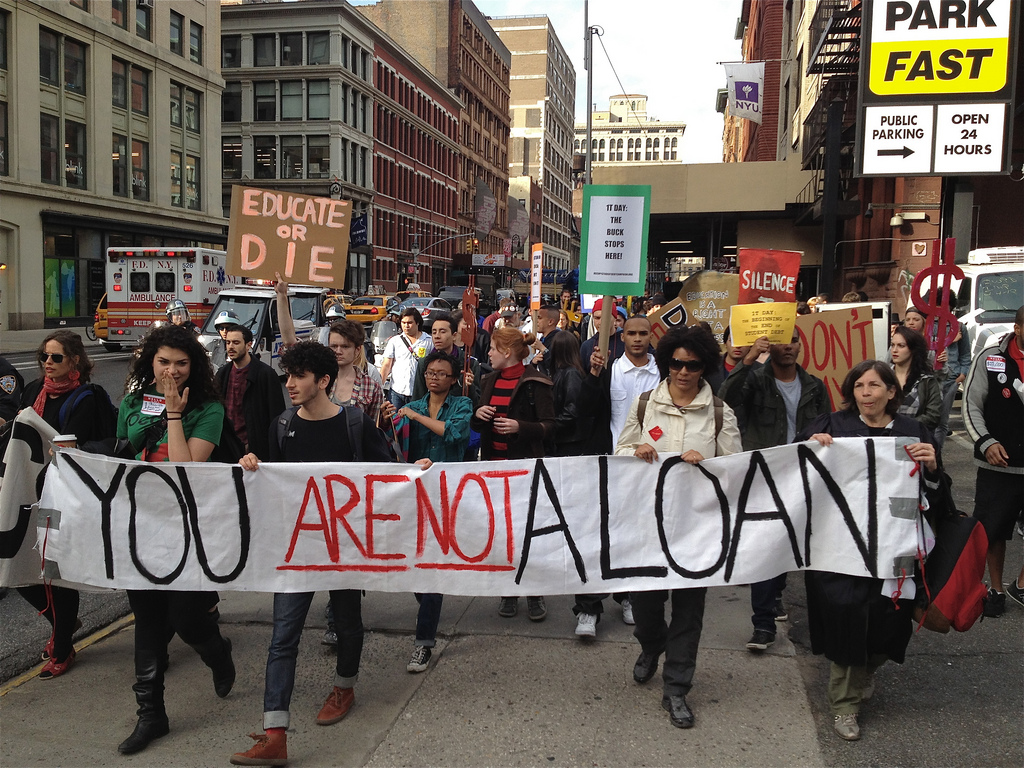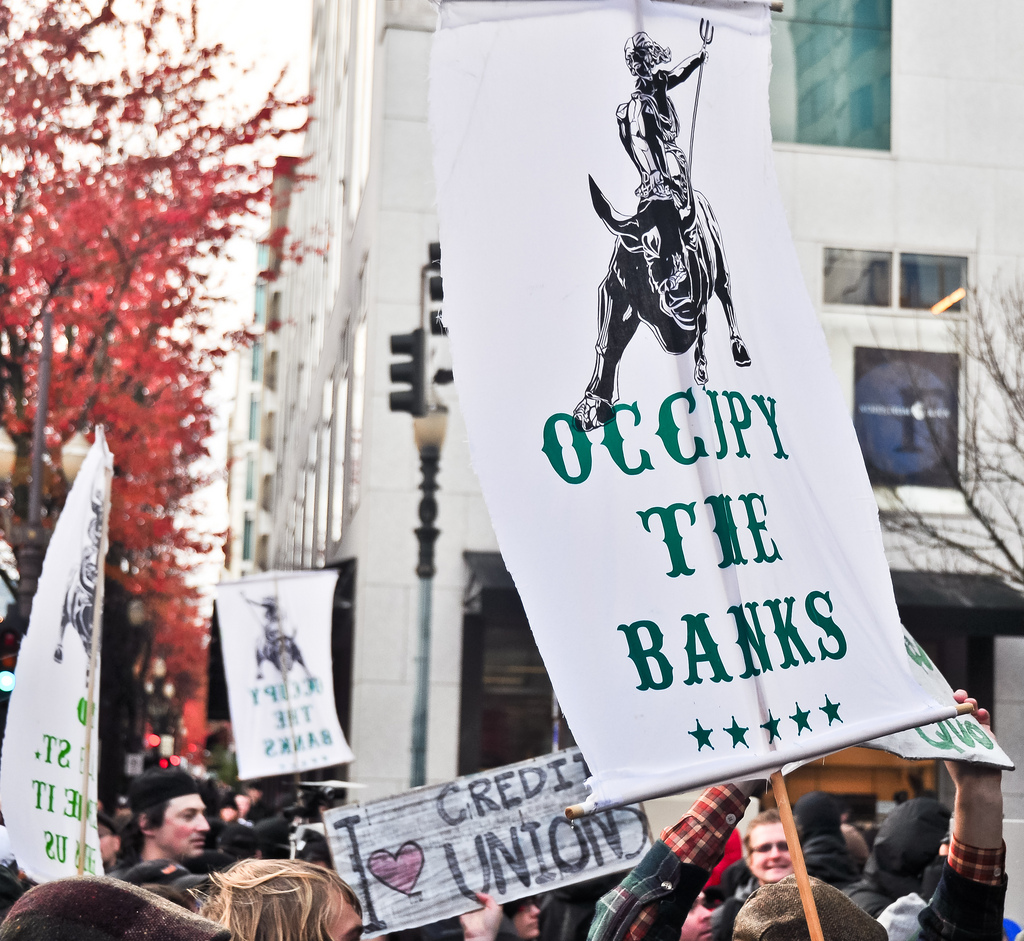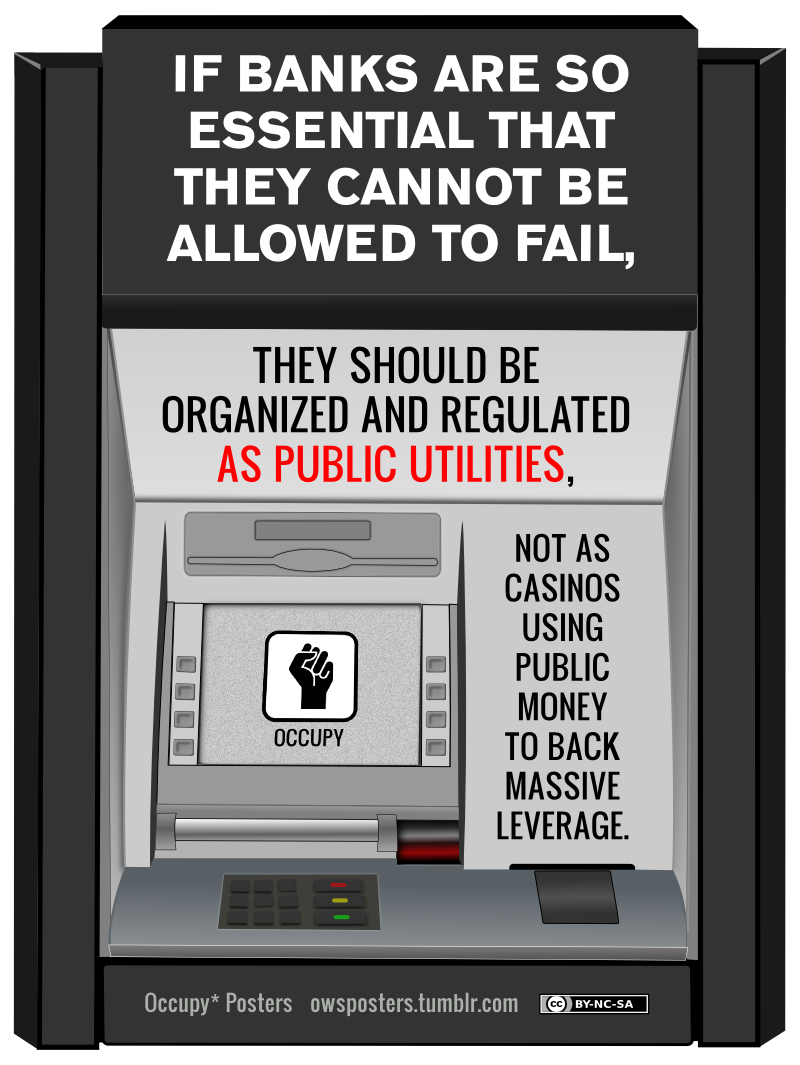
A fundamental question for the new finance system is the role of the Federal Reserve and whether it should remain in private hands. The Federal Reserve is a privately owned U.S. central bank that acts behind closed doors to create money and set interest rates, and it presently puts the interests of the big banks first. The Federal Reserve was originally created by Congress in 1913 and can be altered, nationalized or even dismantled by Congress.
The Fed is a private entity that is controlled by the banks. The 12 Regional Reserve Banks issue shares of stock to its member banks. The Fed is not operated for profit, and the stock may not be sold, traded or pledged as security for a loan. It does pay dividends that are, by law, 6 percent per year. But more importantly, the stock provides banks with votes to elect six of the nine members of the board of governors of the regional banks.
As Leo Panitch told The Real News Network, it is "not just that the banks are too powerful outside the Treasury and Fed. The Treasury and Fed are part of the Wall Street nexus, and they are organized in such a way, and the people who work in them are trained in such a way, as to be reproducing the current system."
There is widespread agreement among economists that there is a need for a central bank to regulate the money supply by setting interest rates and to be a lender of last resort in a financial crisis. However, Bill Black argues that the Fed can be made very small and mechanical in its setting of interest rates, rather than maintaining the current approach, which depends on what members of the Federal Reserve Board of Governors decide.
Further, the Fed needs to be made utterly transparent. "There is no reason for anything the Fed does to be opaque" says Black. In 2010, an "audit the Fed" bill passed in Congress despite aggressive opposition by the Fed. It was not the broad, open audit originally proposed by former Texas Republican Congressman Ron Paul and Rep. Alan Grayson (D-Florida), but it did provide a snapshot audit of a limited time of Fed activity.
As a result of the Government Accountability Office (GAO) audit of the Fed, Senate sponsor Bernie Sanders of Vermont said, "We now know that the Federal Reserve provided more than $16 trillion in total financial assistance to some of the largest financial institutions and corporations in the United States and throughout the world." Among the investigation's key findings was that the Fed unilaterally provided trillions of dollars in financial assistance to foreign banks and corporations from South Korea to Scotland. These decisions were all made without the public, media or elected officials' knowledge, and they would have remained secret without an audit.
In addition, the audit found conflicts of interest. For example, the CEO of JPMorgan Chase served on the New York Fed's board of directors at the same time that his bank received more than $390 billion in financial assistance from the Fed. Sanders urged that "No one who works for a firm receiving direct financial assistance from the Fed should be allowed to sit on the Fed's board of directors or be employed by the Fed."
But the fundamental question is: who should control the money supply? The control of the money supply may be one of the most important functions of government, but currently it is controlled by the Federal Reserve. The Fed creates funds digitally and makes them available to private banks at a low interest rate, which the banks can then use as they like to invest, add to their personal reserves and/or make loans of up to ten times the amount of their holdings.
At present, the government can only issue bonds that are sold to the Fed, banks or investors with the funds raised by those bond issues used for federal spending. These bonds are loans that must be repaid with interest by the government. So in effect, the government places itself in a position of debt by borrowing money from the banks, and then taxpayer dollars are used to pay the debt with interest. If the government created its own (debt-free) money instead, taxpayers would get more value for their dollars and the system could be more democratic and transparent, and could function for the public good.
Henry Ford said, "It is well enough that people of the nation do not understand our banking and monetary system, for if they did, I believe there would be a revolution before tomorrow morning." Why? Because, as Thomas Edison pointed out, "If our nation can issue a dollar bond, it can issue a dollar bill. The element that makes the bond good, makes the bill good ... It is absurd to say our country can issue $30 million in bonds and not $30 million in currency. Both are promises to pay, but one promise fattens the usurers and the other helps the people."
As part of the economic track of the 2011 Democracy Convention, Greg Coleridge argued that the Constitution gives the government the power to create money; Article I, Section 8 says: "The Congress shall have power ... to coin money, regulate the value thereof, and of foreign coin." The creation of money is a public function, perhaps more important than any other part of the commons. As Coleridge points out, public money means we create our own money debt-free rather than borrowing from banks and building up debt.
The American Monetary Institute has put forward a thorough model of remaking the finance system to take power from the banks and give it to the people through the government. The institute point to a bill introduced by former Congressman Dennis Kucinich (D-Ohio), HR 2990, which dismantles the Federal Reserve and puts the necessary functions in the Department of Treasury, where a monetary authority is created to prevent inflationary and deflationary impacts. It would prevent banks from creating money through fractional reserve lending. Instead, money would be created by the government, which spends it into circulation for necessary programs - for example, infrastructure, education, health care.
Economist Jack Rasmus also urges that we "democratize" the Fed and require it to function as a national, Bank of North Dakota-like "public banking institution that would provide cost-only loans to the consumer sector (mortgage, auto, student, installment, etcetera), finance public investment corps for alternative energy, lend to community infrastructure projects, and totally remove the private banks from its board of governors and open market committee decision-making process."
Moving the money creation function into the federal government would place it within the U.S. constitutional system of checks and balances to work for the whole society, not only for the bankers and the privileged. Rather than the banker's corporation, the Federal Reserve, creating money, the Fed would be replaced by a U.S. Central Bank operating within the Department of the Treasury (as one option) which would create money.
Further, Coleridge argues, that there is good reason for governments to control the money supply because there are times when more money is needed in the economy and times when the money supply needs be slowed. When money is created by government, it is an asset and not debt to banks. We should be funding necessary projects and paying our debts with debt-free money. Money should be made for the benefit of the entire economy, not for the benefit of bankers.
Under such a system, the creation of money would be used to serve the interests of society. The money would be created and spent into circulation by the federal government for infrastructure, including the human infrastructure of education and health care. For example, the American Society of Civil Engineers grades U.S. infrastructure D+ and sees an urgent need for over $3.6 trillion in spending to bring existing infrastructure to safe levels by 2020. As the federal government spends money on infrastructure and other urgent needs and funds local and state governments, this money is paid out to contractors, who pay their suppliers and laborers, who pay for their living expenses, and, ultimately, that money gets deposited into banks, which are then in a position to make loans.
Some creative thinking is needed to develop a new central banking system. We should open our minds to a wide range of options. For example, in addition to the approach described here, the finance system could be a fourth branch of government, elected directly by the people; or with a combination of elected and appointed governors to represent different parts of society, for example: energy, housing, health care, workers, transportation. The current system is not working and needs rethinking so that it serves the needs of the people and the society, not only the desires of financiers.
Public Banking: A Public Bank in Every State
Ellen Brown, the president of the Public Banking Institute, argues that we need a public bank in every state and major city. The United States has one model for public banking: the bank of North Dakota. When North Dakota farmers were losing farms to Wall Street, they organized a populist movement, and in 1919, set up the bank of North Dakota. The publicly owned bank recycles state revenues into credit for the state. Thus, North Dakotans keep their money in their community.
The result has been an ongoing success. Even during the current economic collapse, North Dakota escaped the credit crisis and has maintained a budget surplus since 2008, low unemployment and no public debt.
Imagine how different California could be if it had public banks. Brown summarizes: "At the end of 2010, it had general obligation and revenue bond debt of $158 billion. Of this, $70 billion, or 44 percent, was owed for interest. If the state had incurred that debt to its own bank - which then returned the profits to the state - California could be $70 billion richer today. Instead of slashing services, selling off public assets, and laying off employees, it could be adding services and repairing its decaying infrastructure."
How does public banking work? All of the revenues of the state go into the state's public bank, which, like other banks, leverages those deposits into credit. The state bank partners with local banks to fund local projects. For example, when there is a flood or other disaster, the bank quickly helps provide funds to rebuild homes and infrastructure. It is a bank focused on serving the public interest and which returns the profits to the public.
According to Brown, there have been two recent studies that show public banks are less corrupt than private banks and that they are more efficient and more profitable. The North Dakota public bank has complete transparency and accountability - including routine audits by several agencies. It does not pay executives exorbitant salaries and bonuses. It does not reward people for churning out risky loans. And it does not engage in casino investing in risky derivatives. It has lower costs because no advertising is necessary; instead, the government guarantees the bank easy access to liquidity.
The most obvious reason for a public bank is to allow a state to use its resources to build the economy of the state by keeping resources in-state and not sending them to Wall Street, but there are other reasons. The events in Cyprus, where depositors were forced to bail out the banks through seizure of their savings, show there needs to be a banking system that protects people. Cyprus-like seizures of accounts can happen in the United States.
In fact, Ellen Brown reports that as part of the "living wills" banks are required to prepare under Dodd-Frank - which describe how they will survive an economic crisis - the banks include "bail-in" provisions. These plans require depositors (who are unsecured creditors, with fewer rights than derivative investors) to bail out the banks by turning their savings into bank stock, which could be worth only pennies on the dollar in a crash.
Marc Armstrong, executive director of the Public Banking Institute, asks of the states: "What is their plan to prevent city, county and state governments from becoming creditors for the too-big-to-fail banks, the next time these banks lose a multi-billion dollar bet? Because of their fiduciary responsibility to the public, we request that our public finance officials answer the question: what is the risk we have in doing business with too-big-to-fail banks that are apparently now able to seize deposits and convert them to capital?"
The living wills of the big banks make them too risky for city, county and state government money, as well as pension funds' money.
Another concern is that at least 1,350 school districts and government agencies across the nation have turned to a controversial form of borrowing called capital appreciation bonds to finance major projects. These bonds allow the government to avoid paying anything now and pass the debt on to future generations, but at a much greater cost. For example, $22 million borrowed now with no payments due for 21 years would cost the taxpayers $154 million, seven times the amount borrowed, when it is repaid in 2049.
This practice raises questions. Armstrong summarizes: "Why are state and local governments, school districts and public hospitals paying Wall Street banks billions of dollars of interest on municipal bond and capital appreciation bond debt, when we could be paying that same interest to ourselves by issuing credit with a public bank?"
Michael Hudson, a former Wall Street economist, sees the private banking system as cannibalizing the economy, and supports public banks to fund the needs of the nation. When the banks failed, the FDIC should have taken them over, essentially made them into public banks, says Hudson:
If the government would have taken over Citibank it would not have done the kind of things that Citibank did. The government would not have used depositors' money and borrowed money to gamble. It wouldn't have gone down the casino capitalism route. It wouldn't have played the derivatives market. It wouldn't have made corporate takeover loans. None of these are productive from the vantage point of economic growth and raising productive powers and living standards. They would not be the proper behavior of a public bank.
Hudson points to the differences between public and private banking. Private "[b]anks are supposed to make money. And unfortunately, they can make money most easily ... by being parasitic, not by being productive." On the other hand, a public bank "would make loans for long-term purposes to serve the economy and help the economy grow."
With the risks of Wall Street banks increasing and dislike of their banking practices mounting, the public banking movement is growing. It is also being spurred by the Treasury Department and the Federal Reserve's refusal to assist states with their budget problems. Brown reports that 20 states are considering public banks, as are a growing number of cities. Brown says, "We need to get more information out there and develop a groundswell of popular support. Populist movements start with a lot of study, learning about the monetary system." One place to do that is at the June 2-4 public banking conference in California.
Brown would like to see states remove the middleman, the private banks that profit from their deposits, by creating a public bank in every state so states could "bring their money back home and leverage it for their own purposes." There is no good reason for states and cities not to develop public banks and many good reasons to do so.
Change Is Already Happening as People Opt Out of Wall Street
There are a variety of vehicles being developed to help people move their money out of Wall Street banks and the current finance system.
The Move Your Money Project encouraged people to move their money from the big banks to community banks and credit unions. The Occupy movement held a Bank Transfer Day on November 5, 2011, as part of this campaign. The campaign was assisted by bankswhose corrupt practices became notorious and who had started adding fees, like ATM card fees. Three months after Bank Transfer Day, more than 5.6 million customers had moved their money. The campaign continues at Switch Your Banks, which has a consistently excellent blog on banking. Credit unions, a form of cooperative finance, now have assets of over $1 trillion and are becoming major financial players.
People have also been creating time dollars and time banks. This concept, originated by Edgar S. Cahn, allows people to give time to get time; that is, if someone takes an hour to teach someone to read, they can get an hour for a massage from someone else participating in the time bank, and the masseuse can get an hour from a local participating plumber. This work is conducted outside of the tax system and allows people who have skills, but perhaps are unemployed or underemployed, to use their skills in a dignified way to purchase the skills of other people. TimeBanks.org provides a directory of time banks in the United States. If you cannot find one in your community, you can create a time bank.
Another opt-out is local currency. Across the world, 1,900 local communities, including over a hundred in the United States, are nowissuing their own currency. Some communities, such as Ithaca, New York, issue paper currency; others in Canada, Australia, the U.K. or France issue complementary electronic money.
The new Internet currency, Bitcoin, has become popular very quickly. Bitcoin is already bigger than many sovereign currencies and this month broke the $1 billion value mark. Bitcoin is not tied to any particular financial institution and is independent from world governments. Some view Bitcoin as a safe haven for people trying to protect their money from corrupt Wall Street banking, but large investors have begun buying up Bitcoin to avoid taxes. The outcome is uncertain at this time.
More and more questioning has arisen regarding the current debt-based finance system. Occupy Wall Street offshoot Strike Debt is building popular resistance to all forms of debt imposed on us by the banks. They produced the Debt Resistor's Operations Manual, which provides specific information and tactics for understanding and fighting against the debt system. It provides information on how to deal with personal debt, as well as how to work collectively to challenge the way debt undermines communities. Strike Debt also organized aRolling Jubilee where participants buy debt at pennies on the dollar, as debt collectors do, but rather than collecting the debt, they forgive it. So far, they have raised over $578,000 to abolish over $11.5 million in debt.
People are also examining ways to invest locally rather than on Wall Street. Michael Shuman, in "Local Dollars, Local Sense" points out that Americans have $30 trillion invested in stocks, bonds, mutual funds, pension funds and life insurance funds, but not even 1 percent of these savings touch local small business. He shows how people can profit by putting money into building their local businesses and creating resilient local and regional economies. Shuman describes many ways to opt out of Wall Street and opt in to local investment, among them investment clubs and networks, local investment funds, community ownership, direct public offerings, local stock exchanges and crowd funding.
Tying It All Together
In his current book, "What Then Must We Do?" political economist Gar Alperovitz argues that banking is one of two major areas where game-changing, systemic change might develop (the other is health care). As the Wall Street finance system fails us and places us at great financial risk, people are looking for alternatives and thinking about ways to create a finance system that will serve the people. A lot has been done in this area, and a cohesive set of principles is beginning to be developed. These include:
• Investigation and enforcement of the finance system.
• Breaking up the big banks and limiting their size so they are not a systemic risk.
• Remaking the Fed into a small, transparent, mechanical controller of interest rates.
• Transferring the power to create money to the government in a new central bank.
• Creating public banks in cities and states throughout the country.
• Creating systems outside of the finance system that allow for barter, time banks and other alternatives.
• Encouraging community banks and credit unions.
• Encouraging local investment in communities instead of Wall Street investment.
This article does not attempt to cover all aspects of finance. For example, the international systems dominated by the World Bank and International Monetary Fund require major transformation, but that topic would require an article of equal length. We also do not deal with the economy beyond finance, where we see worker-self-directed enterprises or worker cooperatives as the foundation of a new democratic economy that spreads wealth and power more equitably among the people and where a progressive tax system would fund the government.
Finance is the center of the U.S. economy. The current system does not function for most people - or for small- and medium-sized businesses. It is a system that is addicted to casino-like investment, is corrupted by unprosecuted security fraud and funnels money to the wealthiest.
The 2008 collapse had devastating consequences, and since the system remains quite opaque, we do not know whether another collapse is near. It is time to develop an alternative system of finance designed to support the needs of the people and the country, not the needs of bankers. We hope this article adds to an ongoing conversation, and we look forward to your comments so the conversation can be advanced further.
Originally published by Truthout.
3 WAYS TO SHOW YOUR SUPPORT
- Log in to post comments


















